For the opportunity lens overview Carl Zeiss Jena Biometar 2.8 / 80 many thanks to Oleg Shutyak.
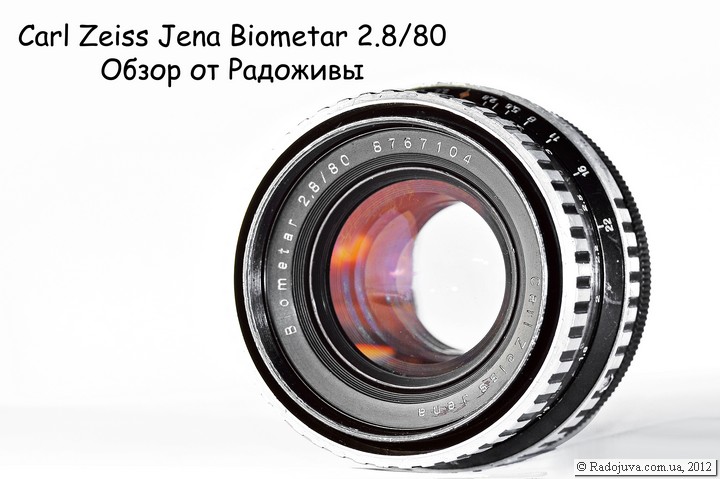
Review Carl Zeiss Jena Biometar 2.8 / 80
There is a newer black version CZJ Biometar 2.8 / 80 with multi-enlightenment and designation Carl Zeiss Jena DDR MC Biometar 2.8 / 80. In this review, an old version of Biometar 2.8 / 80 with single-layer enlightenment is presented.
Due to the striped black and white design of the focus rings and aperture rings, this version of the Biometar is most commonly referred to as a 'zebra'. Also, I want to remind you that there is an even longer-focus Biometar - Carl Zeiss Jena DDR Biometar 2.8 /120.
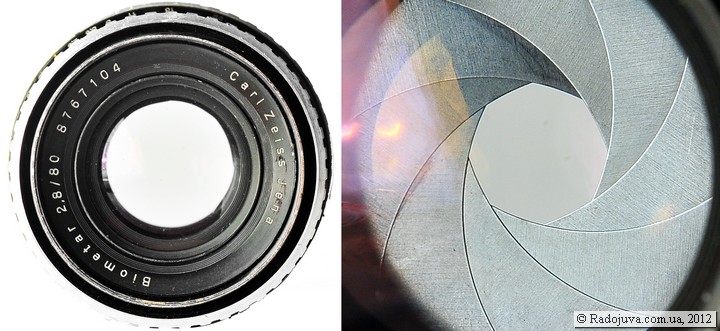
Lens view Carl Zeiss Jena Biometar 2.8 / 80
The Biometar 2.8 / 80 scheme was slightly recalculated in the Soviet Union and a very good Soviet lens was obtained Vega-12B 2.8 / 90. By the way Vega-12B It seemed to me a more interesting lens than this Biometar 2.8 / 80.
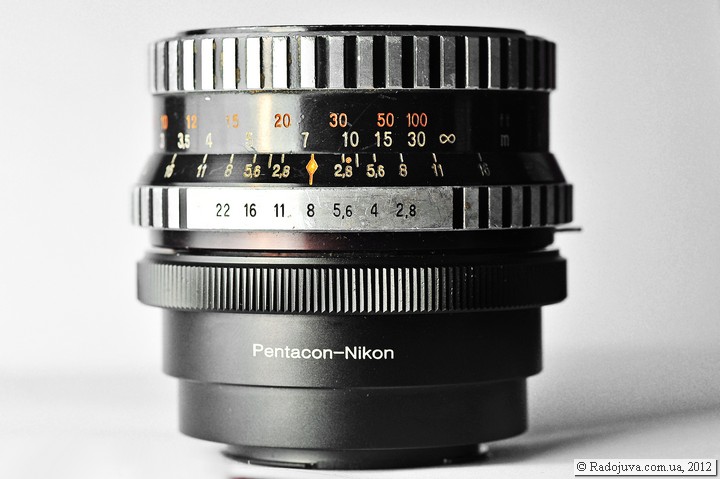
View of the Carl Zeiss Jena Biometar 2.8 / 80 lens with Nikon adapter
TTX Carl Zeiss Jena Biometar 2.8 / 80 (Made in DDR)
Focal length: 80 mm
Aperture: F / 2,8-F / 22.0 with intermediate values 4, 5.6, 8, 11, 16
Number of aperture blades: 8 pieces
Optical design: 5 lenses in 4 groups (Biometar type design)
Bayonet \ thread: Pentacon Six, P6, Bayonet B
Front Filter Diameter: 58mm
Weight: about 260g
MDF: approx 1m
Carl Zeiss Jena Biometar 2.8 / 80 - lens from medium format camera with a Pentacon Six mount, which is identical to the Soviet 'B' mount. Lenses with this mount are easy to use on modern digital cameras.
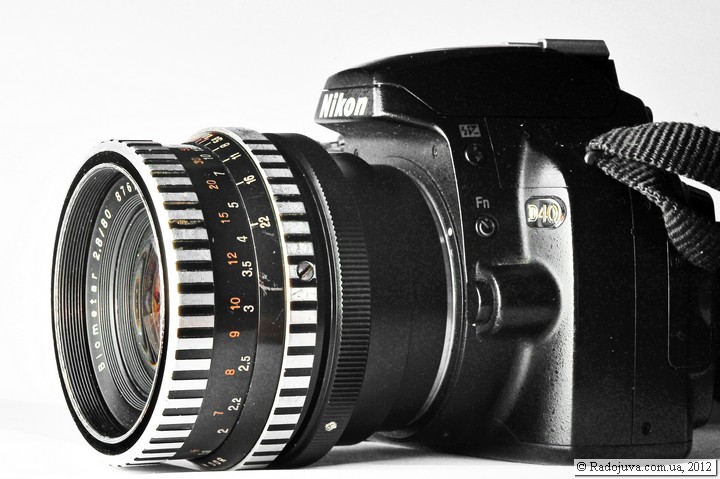
View of the lens Carl Zeiss Jena Biometar 2.8 / 80 with an adapter on a modern Nikon camera
I used Biometar 2.8 / 80 on Nikon SLR cameras using the Pentacon-Nikon adapter (aka KP-6 \ N), for more details, see Soviet lenses. There is also a Pentacon-Canon EOS crossover on Canon, for more details see old lenses at canon.
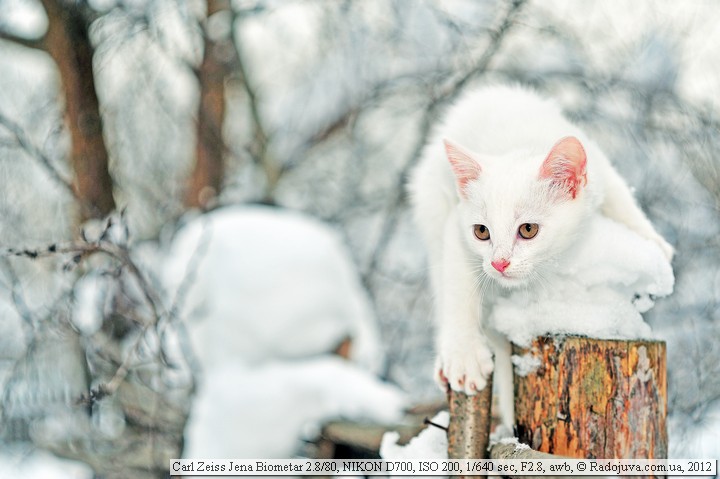
Sample photo on Carl Zeiss Jena Biometar 2.8 / 80
In general, I really like medium format lenses, they have their own unique charm. On a full frame camera EGF will be 80mm, and on Nikon DX crop 120mm, and on Canon 1.6x EGF will equal 128mm. With such a focal length, it is quite convenient to shoot portraits, plus the lens gives an interesting bokeh pattern and has shallow depth of field.
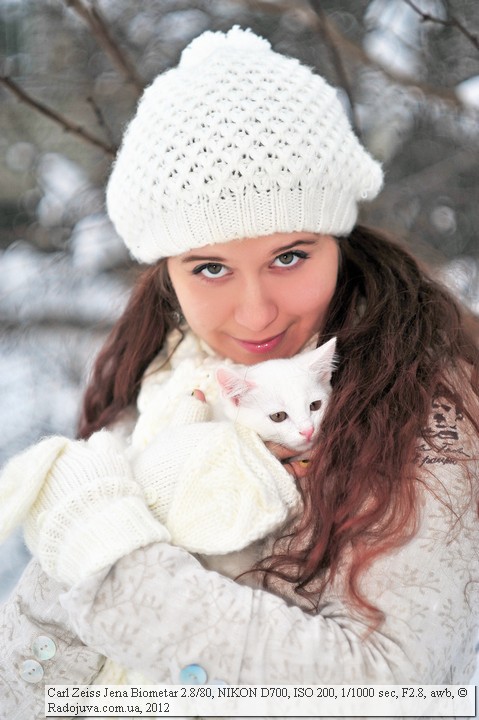
Example photo on Carl Zeiss Jena Biometar 2.8 / 80. Portrait
The lens has a very nice focus ring that rotates all over. 360 degrees, while the front lens does not rotate, and the trunk of the lens is extended by one centimeter. Minimum focusing distance is slightly less than one meter. When focusing on the camera Nikon D700 it was difficult for me to fall into sharpness, the green dot, which indicates precise focusing, didn’t want to catch fire, I was faced with the fact that not only my Biometar is difficult to focus on the green dot.
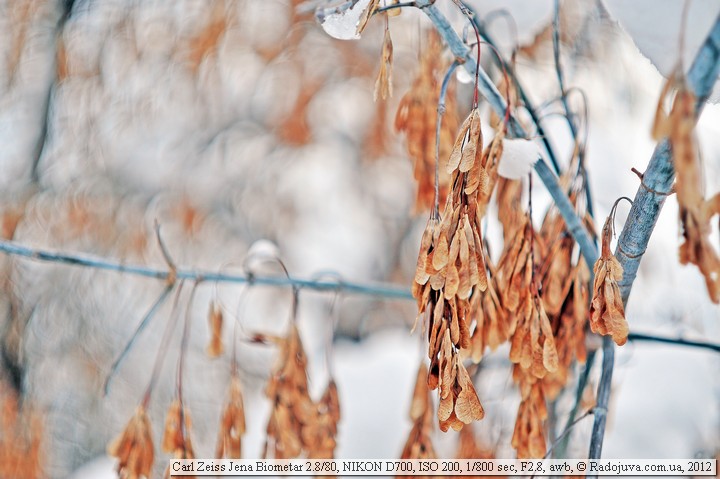
Example photo on Carl Zeiss Jena Biometar 2.8 / 80. Bokeh
The aperture of the lens is built of 8 petals and gives a fairly flat hole. There is an aperture control mode switch on the lens. Aperture values are only fixed from F / 2.8 to F / 22.0.
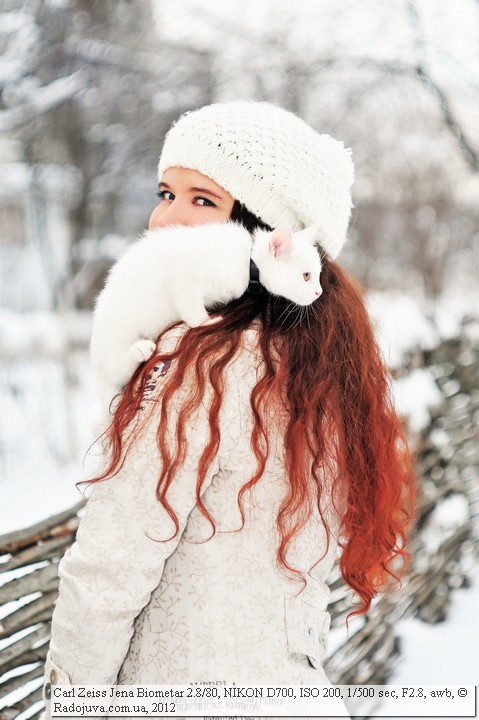
Sample photo on Carl Zeiss Jena Biometar 2.8 / 80
Sample Photos
All photos in the gallery below are shot on a Carl Zeiss Jena Biometar 2.8 / 80 lens and camera Nikon D700, JPEG L Fine, Picture Control VI. Photos without processing, only reduced size and imprinted data from EXIF.
Personal experience
A good portrait lens is a real boon for the photographer. Carl Zeiss Jena Biometar 2.8 / 80 is a slightly specific lens that requires fine focusing. I like drawing biometars lately. Lens all metal, sorry, these autofocus lenses do not do in our time. Compared with Carl Zeiss Jena DDR Biometar 2.8 /120 The 80mm option is much lighter. Considering that the lens is damn old, and at the same time gives out wonderful images, I can’t find any complaints about the lens.
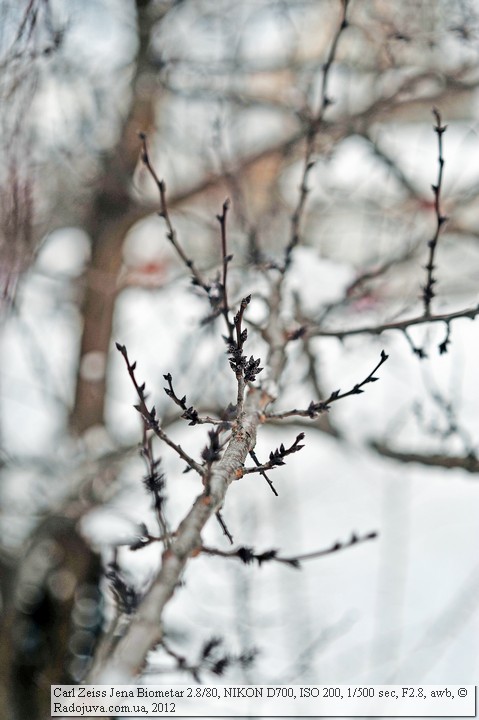
Example photo on Carl Zeiss Jena Biometar 2.8 / 80. Sharpness.
Catalog of modern Carl Zeiss lenses can look at this link.
Comments on this post do not require registration. Anyone can leave a comment. Many different photographic equipment can be found on AliExpress.
Conclusions
The Carl Zeiss Jena Biometar 2.8 / 80 is a good medium format lens. I recommend the newer version Carl Zeiss Jena DDR MC Biometar 2.8 / 80.
Material prepared Arkady Shapoval. Training/Consultations | Youtube | Facebook | Instagram | Twitter | Telegram

















I was guided on a biometric by liveview. It is difficult through the viewfinder, perhaps the problem will be solved by replacing the focusing screen with Kiev or Zenith.
Yes, it’s hard with him.
Wonderful photos, even bigger, and very nice little !!!
And I really like the drawing !!!
The composition of the glass includes Thorium 232 and thorium gives alpha decay !!!
Lenses Tested Radioactive
Kodak Ektar 101mm f / 4.5 (Miniature Crown Graphic camera) lens mfg. 1946
Kodak Ektar 38mm f / 2.8 (Kodak Instamatic 814 camera) lens mfg 1968-1970
Kodak Ektanar 50mm f / 2.8 (Kodak Signet 80 camera) lens mfg. 1958-1962 (3 examples)
Kodak Ektanar 90mm f / 4 (Kodak Signet 80 camera) lens mfg. 1958-1962
Kodak Ektanar, 44mm f / 2.8 (Kodak Signet 30, Kodak Signet 50, Kodak Automatic 35 / Motormatic 35 cameras) lenses mfg. 1959-1969
Kodak Ektanon 50mm f / 3.9 (Kodak Bantam RF camera) lens mfg. 1954-1957
Kodak Ektanon 46mm f / 3.5 (Kodak Signet 40 camera) lens mfg. 1956-1959
Kodak Anastar 44mm f / 3.5 (Kodak Pony IV camera)
Kodak Color Printing Ektar 96mm f / 4.5 lens mfg. 1963
Lenses Reported Elsewhere As Radioactive
Canon FL 58mm f / 1.2
Canon FD 35mm f / 2.0 (versions from the early 1970's)
Canon FD 55mm f / 1.2 SSC Aspherical
Carl Zeiss Jena Pancolar 55mm f1.4 (measured at 2360 nSv / h)
Carl Zeiss Jena Pancolar 50mm f1.8 “Zebra”
Carl Zeiss Jena Biometar 80mm f2.8 “Zebra” “(Only P6 mount version)
Carl Zeiss Jena Flektogon 50mm f4 “Zebra” “(Only P6 mount version)
GAF Anscomatic 38mm f / 2.8 (GAF Anscomatic 726 camera)
Industar 61 L / Z MC (L is for Lantan - radioactive element)
Kodak Aero-Ektars (various models)
Kodak Ektanon 50mm f / 3.9 (Kodak Bantam RF camera)
Nikkor 35mm f / 1.4 (early variant with thorium glass elements)
Olympus Zuiko Auto-S 1: 1,2 / 55 mm (first version with thorium glass elements)
Olympus Zuiko Auto-S 1: 1,4 / 50 mm (only first version “Silvernose” is Radioactive)
Pentax Super Takumar 35mm f / 2 (Asahi Optical Co.)
Pentax Super Takumar 50mm f / 1.4 (Asahi Optical Co.)
SMC Takumar 35mm f / 2.0 (Asahi Optical Co.)
Super Takumar 35mm f / 2.0 (Asahi Optical Co.)
SMC Takumar 50mm f / 1.4 (Asahi Optical Co.)
Super Takumar 50mm f / 1.4 (Only latest Version 2)
SMC Takumar 55mm f / 1.8 (Asahi Optical Co.)
Super Takumar 6 × 7 105mm f2.4 (Asahi Optical Co.)
Yashinon-DS 50mm f1.7 (Yashica)
Yashinon 55mm f1.2 (Tomioka)
Leitz Wetzlar Summicron 5cm f / 2.0 (M39)
Vivitar Series 1 28mm F1.9.
Who travels abroad customs will find out - 100%
In fact, there was some thorium in Takumary, Zuyki and Kodak, but here lanthanum was used, from which the radiation is no more than from a tap with water in the kitchen, I just have a “zebra” in terms of radiation level no more than the natural background.
Once you read that article about radioactive lenses, you should have paid attention to the fact that that amount of radiation is completely harmless and almost completely screened by the carcass.
Thank you Arkady! I have a lens recently, but it has already become a favorite for color, volume and interesting bokeh in one bottle :)
I read about the background .. he doesn’t scare me, I’ll take a dosimeter from a friend, I’ll unsubscribe. week for this instance
I would be grateful for the testimony!
It is checked that the radiation background both in front of the objective and behind the camera (together with the lens) does not differ from the natural one. For Kiev, at the test site, it was equal to 11 micro X-rays per hour
yeah, I also just ordered one ... I'm waiting for the dosimeter readings)
I read this article and agree that 300-400mcr / h on the surface of the lens is not dangerous if you do not wear the lens constantly in your pants and do not sleep with it under the pillow.
But if you take Super Takumar 1,4 / 50, then the background it can reach up to 2500mkr / h and
considering that the permissible radiation rate is 25-30 μR / h, it’s worth considering.
I would like to say something else: if the radiation control system works at the airport during baggage inspection, the lens will be confiscated.
http://www.e1.ru/news/spool/news_id-296494-section_id-87.html
This can happen with lenses purchased from ebay.
I would take a 50mm fix and a telephoto zoom for the trip, well, you can still shirik.
Arkady, your snow-floating cat is just lovely, he didn’t take offense at you for everything? so pitifully looks. Well, the lyrics, medium format lenses should seem to have worse sharpness and contrast, but uniform sharpness across the field and a minimum of vignette. for portraits probably only fit, which is confirmed by your portrait photos, thank you!
The cat is all right, though he was scared of his first snow. Sharpness at the level, the contrast is different on different lenses, the vignette on the FF is minimal.
Hello everyone from Chelyabinsk!
Yesterday I acquired this lens. I liked the picture very much. And following reviews and rumors, I decided together with the seller to check the lenses for pathogenic radiation background. I hasten to please everyone, no pathology was found))) So everything is fine. On Sony, the nex 5n and on the Sony a77 draw exclusively. The lens is valid.
Thanks to Arkady for the reviews, very competent and interesting.
For me, Carl Zeiss Jena Biometar 2.8 / 80 is much more interesting than Vega 12. Its sharpness and bokeh are more expressive in the open. And your photo shows it. Structurally, a biometar will also be better than a vega, which is backlash. Of its minuses, probably only the lack of blackening on the diaphragm blades can bring some inconvenience. Now it’s harder to find this subject in good condition.
I found him in an extremely unsightly form, thanks to Alexander, I reanimated as best I could from fungus, dust, and so on. Enlightenment is partially lost, which affects the contrast and fear of contradiction, and he looked as if nails were leveled with it, BUT ... lightrum easily copes with tasks in exp and contrast, but lightroom drawing cannot, so you do not need to look for an ideal state lens, you need to look for the lens itself
"The lens has an aperture control mode switch"
Specification, this is not a switch, but a wick-lever for covering the aperture for assessing depth of field. When you turn it, the diaphragm closes, when released, the diaphragm returns to its original state - open.
tell me. I found tessar 1: 2.8 f = 80m carl zeiss is very cheap. what kind of animal is it? There’s only a number on the lens. I didn’t find anything about it. If you can briefly mention the above lens. Thank you in advance
http://aflenses.ru/id/25426 - here a little on tessar. And on other m42 look (maybe something will help) - http://aflenses.ru/id/category/m42?sort_by=portrait-primes
Most likely this is Tessar Q1 series produced in the early fifties. It has a multisand aperture.
Three early versions are worth mentioning here, especially the first, white Q1, it is distinguished by increased quality, a multi-sand aperture and an indestructible construct, the subsequent black with white rings and rhombuses on the focus ring, and black with white rings, and the subsequent ones were already made according to a simplified scheme.
Hello!
I found an article via google, generally looking for some information about this lens, as the owner of a donated copy with Pentacon.
Maybe someone will tell you, there is a complete Kiev-60 with an ARSAT C 80mm f2.8 lens, I can’t find any information on it, maybe someone knows something about him, how good he is in business. I can bring it for a review, I live in Kiev on business.
Thank you!
Here is your Arsat - https://radojuva.com.ua/2012/10/obzor-ms-volna-3-2-880/ it's just another name for Wave-3.
I bought myself such a lens.
Delight!
On the camera, I replaced the focusing screen with a matte of increased accuracy (Camera 50D) and it became much easier to focus.
This is my first lens with the FR 80. I am ready to accept the idea that there are lenses with the same focal and better. But there is a buzz in continuous improvement and (importantly) feel the difference :)
The previous post is mine. It turned out that the Canon 85 / 1.8 is much more convenient :) Despite the focusing screen, focusing on sharpness with your eyes (with progressive hyperopia: (it's hard. Canon's autofocus rules. It's a pity to part with Zeiss, but two lenses with such a focal length are too much.)
I sell a "zebra" with an adapter for Canon (sorry for the ad) :)
I had the opportunity to appreciate the drawing of the Karl Zeiss Biometar 2,8 / 80mm "zebra" using the medium format PENTACON SiX TL camera for which this lens is intended. On the 6X6 frame it is a regular standard lens, the first two digits of the number on the lens began with 87 and to be honest I thought it was a 1987 lens! Could you by any chance tell me the meaning of the numbers on the old GDR ovsky photographic lenses and how to determine their year of issue by the numbers?
Google to help :) I somehow found this info. The year is not encoded in the number, but there is simply a range of numbers for the year
Colleagues photo-professional amateurs, good day to all;
Need some advice on this 80 zeboa lens. I recently got it in excellent condition, 99.9 with no repairs. Separately took an adapter for Nikon without a lens, With a chip - directly from Victor Lushnikov.
Actually the question - there is no focusing at infinity, although the sharpness in the portrait is excellent.
What could be the reason and how to “cure”? Thanks in advance
The helicoid fits into the inlet thread. Perhaps in the wrong place it began to wind up during assembly. The alternative is to reduce the height of the adapter. I had a similar situation. Fractions of a millimeter per chip and maximum focusing at 10 meters. I didn't cut further. Enough for a portrait.
I would like to share my impressions of the Wave 3 lens. Until recently, portraits were shot at 24-70 2,8.Nikon. And the latter was the loser. The quality of the pictures from the Wave on Nikon D 700 is much better, but there are some specifics. Shooting in Wave requires a powerful light studio autopilot. flash, since 4-5.6 aperture is desirable for it. It's even better to shoot ice with light. This makes it possible in the studio to adjust the exposure not only with the aperture but also the shutter speed (from a tripod). I use the GreenBean 200 light.
Plastic and bokeh and sharpness at a height. I have an adapter without a chip, I think it is superfluous, because the Nikon d700 has autofocus confirmation. Since 1978 he studied in Ivano-Frankovsk as a photographer, later worked in different photographs and grew up on film. Friendship with Kiev 60 ended in 2004. But I never thought that our “Wave 3” would be able to shine like that on the FF figure.
There is this zeiss only in a black frame, with the Pentacon I got it, and wave-3 together with Kiev-88, there is an opportunity to compare. I liked the wave-3 more
I bought a long-standing dream of Biometar 2.8 / 80 and now I don’t know how to adapt it to the NEX-5R, it does not have a thread but a ring with side latches
“Bayonet / thread: Pentacon Six, P6, Bayonet B” as written in the review. You need to understand: Bayonet or thread: this lens has a Pentacon Six bayonet, aka P6, aka Bayonet B. On the lens with a photo there is just such a bayonet. Look for an adapter from Pentacon Six to SONY NEX
p6-m42
m42-nex
Biometar is one of the best lenses. It pleases with plasticity, sharpness and color rendition. If you get it, take it!